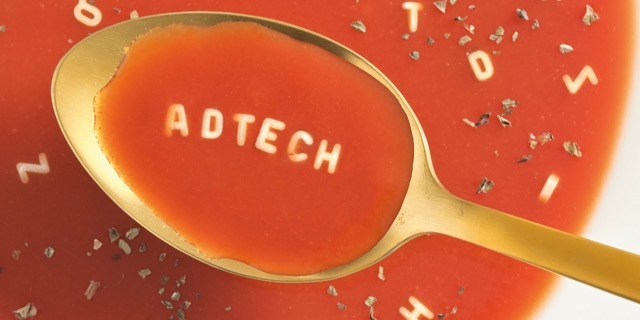AdTech branding: The Good, The Bad & The Ugly
AdTech’s innovation revolution has failed to translate into memorable AdTech branding. That’s embarrassing, especially given that these brands live in the world of media, advertising and publishing.


Tech is booming. New brands are appearing all the time. But hang on, is it just me or do they all blend into one forgettable soup?
The AdTech landscape is congested, bewildering and homogeneous. And where’s the relationship between what these products are called, how they look and what they actually do?
I’m seeing some of the worst crimes against design since The Apprentice season 13. There’s the double-headed arrow cliché; the mandatory light bulb of inspiration; the local authority colour palette; the gratuitous use of whizzy shapes in motion; the impossibly complicated infographic of their proprietary model ™; not forgetting the stock photography of hyperactive people ‘from the future’. In circles.
The irony is most of these brands would look better if they’d been designed by AI. In fact, they’ve generally been art directed by a tech expert, typically a surveillance specialist who started out watching terrorists and now watches consumers.
If we peep over the fence into HealthTech or InsureTech, they’re the same. Familiar patterns that may have originally been influenced by Nielsen’s 10 Heuristics for User Interface Design have now descended into sterile cliché.
The trouble is, ‘different’ isn’t just valuable to a brand, it’s fundamental. As humans, we’re much more likely to remember the misfit. This is known as the Von Restorff Effect after a 1933 experiment by Hedwig Von Restorff. In a disruptive industry, shouldn’t today’s AdTech revolutionaries be looking for which conventions of branding they can overthrow?
AdTech is in the business of innovation: it’s brilliant at inventing new ad formats inside 3D games. Or eradicating cookies. Or making giant leaps forward in artificial intelligence. Or predicting what I’m going to want for my tea. It excels at unconventional answers. Now, it needs some peculiar branding.
Some of AdTech’s identity issues begin with language. The contrived product names may make them easier to protect but Permutive, Algonomy and Audigent sound like suppositories. More seriously, where are the simple analogies or the storytelling that helps us understand what these brands mean in human terms?
Digital transformation strategist, Kimberly Miller who’s worked in AdTech recalls entire trade events where the marketing failed at the most basic level. “Don’t tell me what your tech does,” says Kimberly. “Tell me what your tech will do for me.”
AdTech is full of amazing stories that could be experienced through static and dynamic graphics. How about transformation, change and scaling? Time efficiencies? Or the realisation of human potential? I was just reading about a product that ‘Helps you build a single view of the customer by connecting data from multiple sources’. In the right hands, that could be a dream design brief.
New formats in Connected TV and 3D gaming are opening up possibilities for in-game advertising. Inspired by these rich visual worlds, perhaps this could be the new frontier for AdTech brand identity?
Surprisingly, some of the more established players are showing the newcomers a thing or two. Wavemaker took their ‘Positive Provocation’ strategy into a visual identity system that affects, reacts and responds to the world around it. WPP cousins Mindshare have developed a dynamic system where the brand name opens up and literally shares content. And I like Liveramp’s stylish system, reminiscent of Deutschebank. The simple slash added to their logo creates a literal ramp to represent elevation of the enterprise and accelerated growth.
For those of us who specialise in design for brands, the highest priority in our work is differentiation. We’re most interested in the real estate in people’s minds that a brand can own. Distinctive assets make it easier for our brains to store and retrieve a brand message. Having built up a bank of associations, we’re most likely to buy the brand that demands the least cognitive energy.
As the industry braces itself for the eventual disappearance of third-party cookies, how can AdTech brands avoid the cloak of invisibility? In a world of similarity, it pays to be different.
Talk to NB Studio and discover how thinking and acting differently has supercharged some of the world’s most successful brands. Dan Radley, creative strategist, is an associate of NB.
